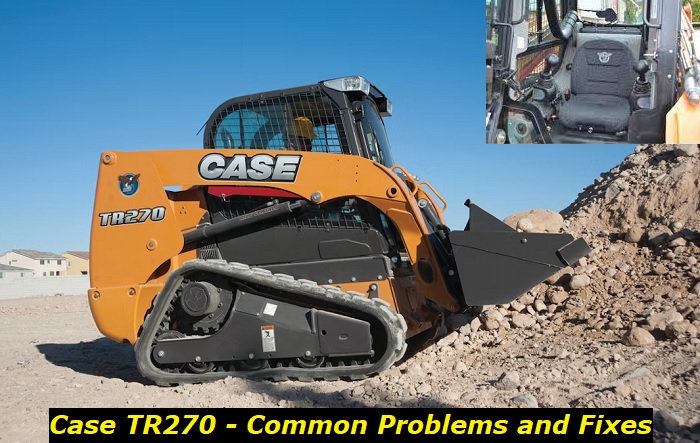Case TR270: Problems, Durability, Repairs
As they say, big things sometimes come in small packages. And that much is true with the CASE TR270.
Weighing in at a shade over four tons, the CASE TR270 packs more power and punch than its counterparts in the same weight class. Many professionals fell in love with this model the first time they test it out on the field. However, despite all the rave reviews and positive criticism it gets, it still suffers from the same set of problems that most skid steer loaders have.

When talking about what are the most common problems that all skid steer loaders suffer from, there are at least three that come to mind. And these problems also apply to CASE TR270.
These problems are:
- Faulty Engine
- Hydraulic Issues
- Control System Problems
Thankfully, because of how common these problems are, they're not that difficult to repair. As such, this article will give you a more in-depth explanation of each issue and what are the ways to repair each one. Additionally, you will also learn just how durable the CASE TR270 is so make sure to continue reading until the end.
What Are The Common Problems Of A CASE TR270 And How To Repair Each?
As mentioned earlier, all skid steer loaders suffer from the same three problems. And the CASE TR270 is no exception. To find out more, take a look at each problem below as well as how to tackle each one:
1) Faulty Engine
Ask anyone who drives a skid steer loader daily what's the most common issue they face when operating one. Chances are, most of them will answer that it's the engine.
Usually, that means that there's something wrong with the skid steer loader's fuel system. It comprises three main parts that need regular maintenance for the skid steer loader to work properly. These three are:
- Fuel Filters
- Fuel Lines
- Tank
Typically, the main culprit among the three is usually the fuel filters. This is especially true if the engine runs on diesel and the skid steer loaders are often working in a dusty environment. As such, you'll need to replace the fuel filters regularly as per the manual, or even earlier at times.
Next, make sure to check both the fuel lines and the tank for any blockages. The presence of foreign material can clog the fuel injectors, preventing fuel to flow properly into the engine. This will cause the skid steer loader to break down often.
Another thing that you need to keep in mind when it comes to a faulty engine is the glow plugs. These components are responsible for helping start the engine, especially on cold days. They are similar to the spark plug in the way they function.
The glow plugs can break over time after too much wear and tear or can come loose. So it's always good to check on them to see if they need replacing or not to ensure that the skid steer loader is working at peak performance.
Last but not least, check the throttle cable of the skid steer loader. This is responsible for controlling how fast you want to go. So if you're having trouble speeding up, it's likely that you're dealing with a loose throttle cable.
2) Hydraulic Issues
Another issue that all skid steer loaders face is hydraulics. Normally, you want your skid steer loader to have the exact amount of hydraulic fluid as recommended by the manufacturer. This ensures that the skid steer loader will work at peak and optimal conditions always.
However, problems like a leak, loose fittings, and a clogged filter can all contribute to your skid steer loader losing power overall. As such, it's good for you to check the hydraulic system if you notice that the power output of the skid steer loader is far less than normal. Before you do though, make sure to wear safety goggles and gloves to prevent accidents due to the high pressure involved.
The first thing you need to check is the hydraulic fuel filter. Blockages can prevent hydraulic fluid from flowing normally, thereby reducing the amount of power that a loader typically has.
Next, check for any loose parts, holes, and leaks in the hydraulic system. To help you spot where they are, it's best to keep the engine and the hydraulic system running.
While doing this, check the seals and fittings on the control valves as well. You want them to fully open and close without any strain or difficulty.
In the end, you need to make sure that the skid steer loader has just the right amount of hydraulic fluid, not too much or too little. Additionally, tighten up any loose parts and replace the ones with leaks or corrosion to ensure that the skid steer loader is at peak performance.
3) Control System Problems
Last but not least are the issues that come from the control system. Most notably, the joysticks are in charge of steering and controlling the loader.
The usual suspects that cause these to happen are loose connections and a faulty circuit board. For the former, it's just a matter of reconnecting and tightening up the steering and loader connections. As for the latter, your only option is to replace it with a new one.
Normally, you will see a fault code when the joystick is not working properly. It usually reads as code 5217 when displayed.
Additionally, check the connections and wires for any corrosion. You will need to replace such parts to avoid issues in the future like the circuit board malfunctioning or draining the skid steer loader's battery when not in use.
How Durable Is the CASE TR270?
For a large skid steer loader, the CASE TR270 is on the smaller end as it barely meets the requirements for being one. But as mentioned earlier, this skid steer loader more than makes up for it with its sheer performance and power output.
The CASE TR270 can run all day long thanks to its 19.5-gallon fuel tank. Combine that with a 74-horsepower engine, and you can see why a lot of experts are impressed with its work rate.
Additionally, it measures a little over five feet across, making it fit easily in the back of most trailers. Its loader also comes with an operating capacity of 2,700 tons, further proving just how powerful of a machine it is.
It also comes with a removable side panel and plenty of hydraulic pressure-release valves. This helps decrease the maintenance time while upping the work productivity of the machine. In addition to that, all the sensitive parts like the engine, filters, and fuel lines are at the rear of the machine for quick access.
The cab measures nearly three feet wide, allowing for a more comfortable experience when operating the machine. With the cab at the front, this design offers the operator the best visibility while working. And due to the sealed and pressurized cab, provides maximum comfort to the operator from all the noise, dirt, and fumes that the machine will produce.
To top it all off, the undercarriage of the CASE TR270 features fewer moving parts than your average skid steer loader. This helps improve the machine's overall balance and durability while reducing maintenance costs and increasing the undercarriage's lifespan.
The CASE TR270 will last an average of 5,000 operating hours, depending on how often you use it and the work you use it for. In the end, with proper care and maintenance, this skid steer loader will last you for the next few years or more.
Conclusion
Surprisingly, the CASETR270 does not come with many flaws, besides the usual ones that all skid steer loaders share. Even if you do come across a problem that you have not yet experienced before, there's always a solution for it in the manual that it comes with. In short, all the problems that you'll usually face are all things that you can handle by yourself.
If you're not too confident when it comes to handling machinery though, then there's no shame in calling a professional for help. Additionally, if a problem does come up where there's no immediate solution to it, have an expert take a look and troubleshoot the problem for you. In the end, the CASE TR270 is a great machine with very few flaws to it.

Add comment